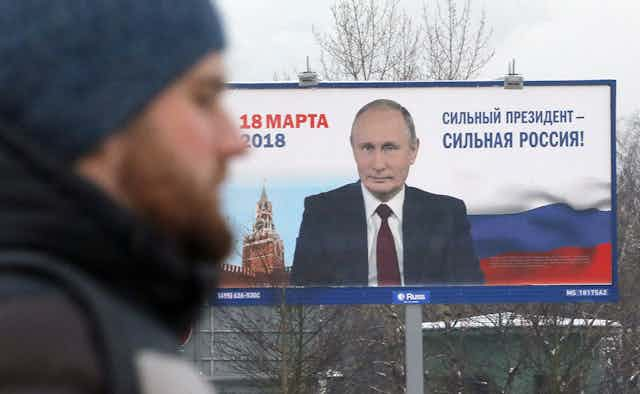Russia’s presidential elections are scheduled to take place on March 18. Of the 70 candidates who originally threw their hat in the ring, only eight were able to successfully clear the hurdles of the nomination and registration process.
Aside from the incumbent, Vladimir Putin, the candidates include Vladimir Zhirinovsky (Liberal Democratic Party of Russia), Boris Titov (Russia’s Business Ombudsman, nominated by the pro-business Party of Growth) and Sergei Baburin, of the conservative All-Russian People’s Union, Ksenia Sobchak of the liberal Civil Initiatives Party, and Grigori Yavlinsky, of the social democratic party Yabloko. Then there are two supposedly left wing candidates: Pavel Grudinin, who was nominated by the Communist Party of the Russian Federation (even although he is not a member of the party), and Maxim Suraikin, nominated by the Communists of Russia Party – which some believe is a spoiler party set up by the Kremlin to steal votes from the Communist Party of the Russian Federation
The registration process is not a level playing field. To pass the first stage, candidates had to close down any foreign bank accounts and provide detailed information about their income and property to the Central Election Commission. They were then given just 35 days to collect signatures – 100,000 if they were nominated by a non-parliamentary party, and 300,000 if nominating themselves. Candidates can be disqualified if 5% of their signatures are declared invalid, and parties with seats in the national parliament were exempt from collecting signatures altogether.
Putin’s plan
According to reports, the Kremlin is hoping for a minimum turnout of 70%. It also wants a minimum of 70% of the vote for Putin
Putin is standing as a self-nominated candidate rather than as a representative of the Kremlin’s party, United Russia. That’s not surprising given how much more popular the man is than the party.
According to the latest survey conducted in March 2018, United Russia was supported by just 52% of those polled. Putin’s personal approval ratings, meanwhile, generally hover around the 80% mark. According to a poll conducted on March 9, 69% of voters intend to choose Putin.
Grudinin is the nearest candidate to Putin in the polls, but even he trails far behind with just 7% support. He is followed by Zhirinovsky, on 5% and Sobchak has a mere 2%; Yavlinsky and Baburin have 1% and the others below 1%.
So Putin looks set to easily win a fourth term in office, and he will most likely gain the 70% or more that the Kremlin is seeking. Turnout, however, is another matter.
The worry
The Kremlin is clearly worried that low turnout would severely erode Putin’s legitimacy. The issue of turnout became highly politicised after charismatic opposition leader Alexei Navalny called for a boycott of the elections.
Navalny has a large following thanks to his skillful use of social media and his organisation of anti-corruption demonstrations. He is, however, banned from participating in the elections because he has a criminal conviction for fraud. Navalny argues that this conviction was politically motivated and was deliberately orchestrated by the Kremlin to prevent him from competing in the elections.
But Navalny isn’t Russia’s only conspicuous opposition figure. There’s also Sobchak, daughter of the former mayor of St Petersburg, Anatoli Sobchak, with whom Putin worked in the 1990s.
There are suspicions that she is not a genuine candidate and that her candidacy has been stage-manged by the Kremlin in order to boost turnout.
Many Russian commentators argue that without the Kremlin’s support, Sobchak would never have been able to gather 300,000 nominating signatures on time. She’s also clearly out of step with the views of the vast majority of Russia’s electorate, what with her professed ultra-liberal stance, and her opposition to Russia’s annexation of Crimea. Those go some way to explaining her very low poll ratings.
The Kremlin is also seeking to attract citizens to the polling stations by organising local concerts, sports events and fairs on polling day. In addition, more than 100 local non-binding referendums are planned to take place at the same time as the presidential vote. Latest polls suggest that turnout will be between 60% and 70%.
Why is Putin so popular?
Throughout his period in office, Putin has astutely put forward policies that mesh with the values of the vast majority of Russia’s population. He’s also widely credited with rescuing the country from the economic and political chaos of the 1990s. There are strong positive correlations between the health of the Russian economy and the levels of citizen approval for the Putin regime.
So, for example, over the period 2000-2008 when Russian GDP grew rapidly, and the number of people living in poverty was halved, Putin’s approval rating rose from 35% to 78%. And even as Russia was hit by the 2008 economic crisis and went into recession after the imposition of Western sanctions in 2014, Putin was able to bolster his legitimacy by tapping into strong patriotic sentiments.
Putin has capitalised on the conflict in Ukraine and Russia’s annexation of Crimea by successfully propagating the view that the country is surrounded by hostile enemies, and that he is the only person who can guarantee Russia’s security.
It will therefore be no surprise to see Putin elected for a fourth term and if he completes his six year term in office he will have been in power for 24 years, if we include his spell as prime minister over the period 2008-12.

